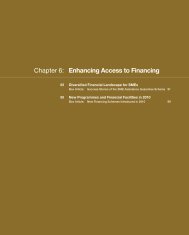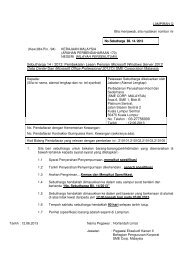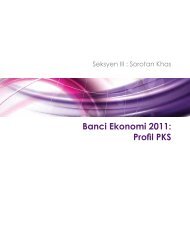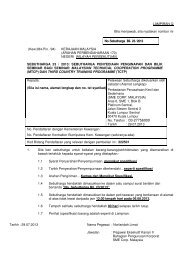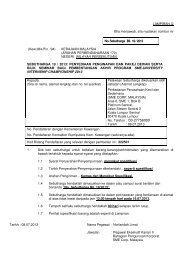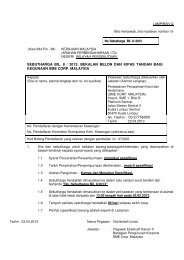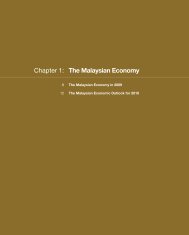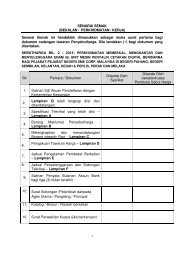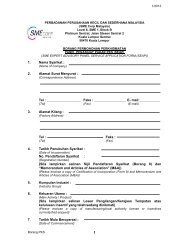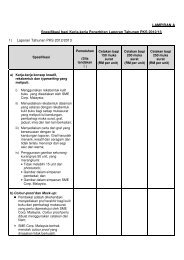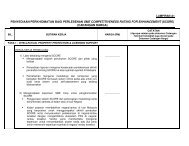Executive Summary.pdf - SME Corporation Malaysia
Executive Summary.pdf - SME Corporation Malaysia
Executive Summary.pdf - SME Corporation Malaysia
You also want an ePaper? Increase the reach of your titles
YUMPU automatically turns print PDFs into web optimized ePapers that Google loves.
<strong>SME</strong> MASTERPLAN 2012-2020<br />
5<br />
<strong>Executive</strong> <strong>Summary</strong>
6<br />
<strong>SME</strong> MASTERPLAN 2012-2020<br />
<strong>Executive</strong> <strong>Summary</strong><br />
Small and medium enterprises (<strong>SME</strong>s) including microenterprises have played<br />
an important role in fostering growth, employment and income, and have been<br />
integral to <strong>Malaysia</strong>’s economic transformation process. Going forward, amidst<br />
the changing external environment and growing global competition, <strong>Malaysia</strong><br />
requires a 'game changer' to transition the economy to a high income nation by<br />
2020. In the last few years, <strong>SME</strong>s have witnessed a marked improvement in their<br />
performance. Real Gross Domestic Product (GDP) of <strong>SME</strong>s has consistently<br />
outperformed that of the overall economy, expanding at an average annual<br />
growth rate of 6.8% versus 4.9% for the overall economic growth in the period<br />
2004 – 2010. This was due mainly to definitive policies by the Government<br />
through the National <strong>SME</strong> Development Council (NSDC). The Council has laid<br />
a solid foundation in <strong>SME</strong> development via a comprehensive framework that<br />
brought together more than 15 Ministries and 60 Agencies to work towards a<br />
common objective.<br />
<strong>SME</strong> Masterplan as the 'Game Changer'<br />
Going forward, <strong>SME</strong>s will assume a greater role in the economy not only as<br />
an enabler but as a key driver of growth as well as to achieve inclusive and<br />
balanced growth. <strong>SME</strong>s are critical to the economic transformation as they form<br />
the endogenous source of growth and bedrock of private sector activity. <strong>SME</strong>s<br />
also stimulate innovation and act as stabilisers of growth during an economic<br />
slowdown. Hence, it is vital to build a strong base of vibrant and competitive <strong>SME</strong>s<br />
that are resilient to challenges, including pressures arising from liberalisation of<br />
markets.<br />
Meeting the Vision 2020 of a high income nation is a challenging task and a fresh<br />
approach is required to accelerate the growth of <strong>SME</strong>s. The aim is to increase<br />
the contribution of <strong>SME</strong>s to the economy. This would necessitate a quantum<br />
leap in growth and transformation to higher value-added activities that are<br />
knowledge intensive. The <strong>SME</strong> Masterplan will therefore be the 'game changer'<br />
in navigating the new development path for <strong>SME</strong>s across all sectors until 2020.<br />
The new strategy will build on existing initiatives for <strong>SME</strong>s by strengthening the<br />
current framework and to align to the macro policy reforms.
Catalysing Growth and Income 7<br />
A New Approach to <strong>SME</strong><br />
Development<br />
The <strong>SME</strong> Masterplan will take a very different<br />
approach from previous strategies. It will be based<br />
on evidence and sound analysis. The Masterplan<br />
will adopt an outcome-based approach in <strong>SME</strong><br />
development by putting in place a comprehensive<br />
Monitoring and Evaluation (M&E) system. It will<br />
be a 'live plan' that can be fine-tuned to remain<br />
relevant with changing times. Programmes will be<br />
demand-driven, catering to the business needs of<br />
<strong>SME</strong>s. The programmes are specifically aimed at<br />
addressing market imperfections and information<br />
asymmetry, and will have a clear timeline for exit.<br />
The Masterplan also has a strong element of<br />
public-private partnership and hence, encouraging<br />
shared responsibility and accountability between<br />
Ministries and Agencies and the private sector.<br />
Meanwhile, the Government would act as facilitator<br />
and catalyst, creating an enabling environment<br />
and ecosystem for <strong>SME</strong>s to thrive by encouraging<br />
entrepreneurship, innovation and investment.<br />
• Low productivity compared to those in<br />
the region and more advanced countries.<br />
The productivity of <strong>Malaysia</strong>n <strong>SME</strong>s which<br />
is estimated to average RM47,000 in 2010,<br />
is about one-third of large enterprises<br />
(RM148,000). When compared internationally,<br />
<strong>SME</strong>s in Singapore and the United States are<br />
four times and seven times more productive<br />
respectively than <strong>Malaysia</strong>n <strong>SME</strong>s;<br />
• Lower business formation than high<br />
income countries. The Masterplan uses<br />
average entry density to gauge the business<br />
dynamism and entrepreneurship level which<br />
reflect the rate of business formation. It is<br />
found that <strong>Malaysia</strong> stands relatively high<br />
among emerging markets, but substantially<br />
below that of high income countries due<br />
partly to lack of perceived entrepreneurship<br />
capabilities;<br />
Diverse Nature of <strong>Malaysia</strong>n<br />
<strong>SME</strong>s<br />
<strong>SME</strong>s constitute 99.2% of total business<br />
establishments in the country. Based on the latest<br />
statistics, <strong>SME</strong>s contribute 32% of GDP, 59%<br />
of employment and 19% of exports. Bulk of the<br />
<strong>SME</strong>s (87%) are in the services sector, followed<br />
by manufacturing (7%) and agriculture (6%).<br />
Microenterprises represent majority (79%) of <strong>SME</strong>s.<br />
By location, most of the <strong>SME</strong>s operate in the Klang<br />
Valley (35.7%), followed by Johor (10.3%), Perak<br />
(8%) and Kedah (6.8%). The Masterplan revealed<br />
four key characteristics of <strong>SME</strong>s in <strong>Malaysia</strong> which<br />
include:
8<br />
<strong>SME</strong> MASTERPLAN 2012-2020<br />
• Small number of firms contributes the<br />
most to the economy. Findings showed that<br />
fast-growing firms accounted for 70% of the<br />
additional GDP and 46% of the additional<br />
employment created in the period 2000 –<br />
2005; and<br />
• Material share of informal sector in the<br />
economy. It is estimated that the informal<br />
sector accounts for about 31% of the Gross<br />
National Income (GNI) and these are usually<br />
microenterprises where the owners are selfemployed<br />
with very few partners.<br />
Positive Impact of <strong>SME</strong><br />
Development Programmes<br />
For the first time, the Government in collaboration<br />
with the World Bank undertook an impact evaluation<br />
involving rigourous technical assessment on 15<br />
<strong>SME</strong> development programmes. The findings<br />
showed positive results from these programmes.<br />
In particular, the Human Resource Development<br />
Fund (HRDF) had shown a strong positive impact<br />
on investment, capital intensity and productivity.<br />
The rest of the programmes on non-human<br />
resource development had also indicated positive<br />
impact on capital intensity, total factor productivity<br />
(TFP), employment, as well as total output and<br />
value-added. The analysis concluded that every<br />
1% increase in programme support will result on<br />
average 1 - 5% gain in performance. However,<br />
there was limited impact on labour productivity<br />
and no impact on wages.<br />
During the Ninth <strong>Malaysia</strong> Plan period (2006 –<br />
2010), a total of RM26 billion was spent in <strong>SME</strong><br />
development programmes, representing 11.6%<br />
of the total development expenditure during the<br />
period. The programmes were aimed to address<br />
constraints faced by <strong>SME</strong>s and are categorised<br />
under the three strategic thrusts, namely<br />
enhancing access to financing; building capacity<br />
and capability; and strengthening enabling<br />
infrastructure. While there was evidence on the<br />
impact of these programmes at the macro level<br />
as seen in the encouraging performance of <strong>SME</strong>s<br />
in recent years, there was uncertainty on whether<br />
the result was due to the effectiveness of the<br />
programmes or merely from the synergistic effects<br />
of improved coordination under NSDC or due to<br />
both reasons.
Catalysing Growth and Income 9<br />
Growth Levers for <strong>SME</strong>s<br />
In order to accelerate the performance of <strong>SME</strong>s to the next level, it is important to understand the<br />
forces that drive <strong>SME</strong> performance. Analysis of findings from the World Bank Productivity and Investment<br />
Climate Surveys has revealed that there are six factors which influence the performance of <strong>Malaysia</strong>n<br />
<strong>SME</strong>s, namely:<br />
• Innovation and technology adoption;<br />
• Human capital development;<br />
• Access to financing;<br />
• Market access;<br />
• Legal and regulatory environment; and<br />
• Infrastructure.<br />
Currently <strong>SME</strong>s are not achieving high performance due to challenges faced in each of these areas (refer<br />
to Chart 1). Of importance, these challenges need to be addressed simultaneously to achieve the desired<br />
results as shortcomings from any of these factors can weigh down on the overall growth prospects of<br />
<strong>SME</strong>s. The aim of the Masterplan is to address these challenges to unleash the growth potential of <strong>SME</strong>s<br />
to achieve Vision 2020.
10<br />
<strong>SME</strong> MASTERPLAN 2012-2020<br />
New <strong>SME</strong> Development Framework<br />
Aligning to National Aspiration<br />
new<br />
framework<br />
The Masterplan has proposed a new framework to align <strong>SME</strong><br />
development to the broader national aspirations of achieving<br />
a high income economy by 2020 via innovation-led and<br />
productivity-driven growth (refer to Chart 2). There are five<br />
elements to the new framework, namely vision, goals, focus<br />
areas, action plan and the institutional support. Each of these<br />
goals has specific targets that need to be met in order to<br />
achieve the macro targets in terms of <strong>SME</strong> contribution to GDP,<br />
employment and exports by 2020:<br />
• 41% share of GDP (2010: 32%);<br />
• 62% share of employment (2010: 59%); and<br />
• 25% share of exports (2010: 19%).
Catalysing Growth and Income 11<br />
Growth Opportunities in High Value Activities<br />
The services sector is expected to be the main growth driver of the economy, with its share to GDP<br />
projected to rise to 65% by 2020. The on-going liberalisation measures will result in new challenges<br />
for <strong>SME</strong>s in the sector and at the same time, it will also usher new opportunities. Thus, <strong>SME</strong>s must<br />
prepare themselves to face the challenges and build their capacity and capability to reap the benefits of<br />
liberalisation. <strong>SME</strong>s are also poised to benefit from the National Key Economic Areas (NKEAs) announced<br />
by the Government. About 60% of the Entry Point Projects (EPPs) earmarked are expected to benefit<br />
<strong>SME</strong>s across all sectors. The challenge is for <strong>SME</strong>s to migrate from the current back-end of the value<br />
chain in the NKEAs, i.e. from the low to medium value-added activities to higher end of the chain. The<br />
<strong>SME</strong> Masterplan is expected to spur recalibration of activities towards high value activities as in Chart 3.
12<br />
<strong>SME</strong> MASTERPLAN 2012-2020<br />
Accelerating Growth Through<br />
High Impact Programmes<br />
In order to achieve the ambitious targets set in the<br />
<strong>SME</strong> Masterplan, the initiatives under the Action<br />
Plan have to be impactful to bring about the<br />
desired results. These initiatives were based on the<br />
following eight guiding principles:<br />
• Consistent with the national strategic<br />
direction;<br />
• Addresses market failures and information<br />
asymmetry;<br />
• Catalyst to develop private service providers;<br />
• Avoid substituting private funds with public<br />
funds;<br />
• Ensure private sector involvement;<br />
• Results must be measurable;<br />
• Highest impact from funds; and<br />
• Clear accountability and delineation of roles.<br />
The initiatives were reviewed further to check on<br />
relevancy, impact, priority and alignment to the<br />
Plan. Finally, 32 initiatives have been identified<br />
under the Action Plan, which include six High<br />
Impact Programmes (HIPs) that would make the<br />
difference in meeting the goals of the Masterplan.<br />
Hence, it is critical to ensure that the HIPs are<br />
being successfully implemented. In addition,<br />
there are 14 other initiatives clustered under four<br />
thematic areas. Recognising the unique business<br />
environment in East <strong>Malaysia</strong>, the Masterplan has<br />
also proposed specific measures for <strong>SME</strong>s in East<br />
<strong>Malaysia</strong> and other macro measures.<br />
Building Capacity Towards<br />
Implementation Success<br />
The most critical factor to ensure successful<br />
implementation of the <strong>SME</strong> Masterplan is the<br />
existence of a strong central agency to implement<br />
the Masterplan. Therefore, the role of <strong>SME</strong><br />
<strong>Corporation</strong> <strong>Malaysia</strong> (<strong>SME</strong> Corp. <strong>Malaysia</strong>)<br />
will need to be further strengthened. This would<br />
require reorganisation of the existing structure and<br />
improvement in the coordination mechanism to<br />
allow greater empowerment to enable the Agency<br />
to function effectively in executing the Plan. <strong>SME</strong><br />
Corp. <strong>Malaysia</strong> would need to be given sufficient<br />
authority and resources and have a more active role<br />
in the budgetary decision on <strong>SME</strong> development.<br />
The agency would also need to establish a<br />
comprehensive Monitoring and Evaluation (M&E)<br />
system besides devising a risk mitigation plan to<br />
ensure smooth implementation of the Plan.
Catalysing Growth and Income 13<br />
A New Beginning for Greater<br />
Heights<br />
The <strong>SME</strong> Masterplan will set the stage for a new<br />
beginning to bring <strong>SME</strong>s to the next level. The Plan<br />
has laid a clear path to achieve the ambitious goals<br />
aligned to the overall vision of creating globally<br />
competitive <strong>SME</strong>s that enhance wealth creation<br />
and contribute significantly to the social well-being<br />
of the nation. The challenge lies in the execution of<br />
the Plan. This would require a paradigm shift in the<br />
mindset of all players involved in <strong>SME</strong> development<br />
to embrace the new approach and harness the<br />
growth potential of <strong>SME</strong>s in the country.
14<br />
<strong>SME</strong> MASTERPLAN 2012-2020



